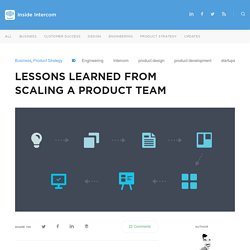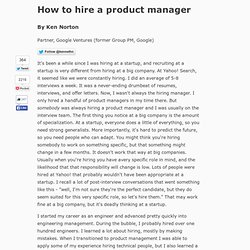

Lessons learned from scaling a product team. There’s been lots written about how Internet business should build software, from books like The Lean Start-Up, and posts from Google Ventures, but not many examples where startups open up their process and show how it really happens.

Back in 2013, Spotify talked about how they build, but other detailed examples are hard to find. Maybe that’s because it’s a messy reality and people can be uncomfortable sharing that in public. Given the abundance of abstracted advice, primarily from advisors rather than operators, and lack of actual examples happening from fast growing startups, we thought it would be valuable to share more about how we work at Intercom.
In the last 12-18 months, over dozens of releases from incremental improvements to huge redesigns, we’ve learned a lot about scaling a product building team, and the nitty gritty involved in getting valuable product out the door as fast as possible. Our process is broken down into four main areas: Product Managing your job hunt. Product managers come from a lot of different backgrounds — startups, consulting, software engineering, QA,… which are all relevant to the position.

So what is the best way to break into product management? Short answer is to show that you are already doing a product manager’s job. If you’re in one of these positions, take over some broader responsibilities corresponding to a PM’s job. “There’s a catch 22 about product management roles. The PM Interview - practice product manager interview questions. Understanding the User in User Experience. What is UX Design? Managing Tensions In Online Marketplaces. Online marketplaces are undergoing a Renaissance as entrepreneurs innovate on an entirely new generation of them.

But as I’ve argued before the same core principles of maintaining them apply. Specifically, I believe all of these marketplaces need to nurture and manage conditions of “perfect competition” to thrive. A big part of managing two-sided marketplaces involves managing tensions between the two, often opposing “sides”. Typically these are consumers on one side and micro-entrepreneurs or small businesses on the other. Depending on the type of marketplace it is, this tension could be between buyers and sellers (Amazon, eBay, etc.); diners and reviewers and restaurants and establishments (OpenTable, Yelp); guests and hosts (Airbnb); riders & drivers (Lyft, Uber); and so on. These two sides are wholly reliant on each other, yet also have different perspectives and interests that have the potential for tension and conflict.
Featured Image: 周小逸 Ian/Flickr UNDER A CC BY 2.0 LICENSE. Through The Fire: What TaskRabbit Learned From Its Big Backlash. “Right after we launched the new TaskRabbit, not everyone was happy.”

After years of being a CEO, Leah Busque knows to choose her words carefully. But speaking with her in person at a conference room in TaskRabbit’s San Francisco headquarters, it’s apparent in her voice and demeanor that she knows she’s making an understatement. It’s hard to imagine that there was anything happy about the backlash that occurred after TaskRabbit rolled out a dramatically different version of its platform on July 10, 2014. Sitting across the table, Jamie Viggiano, TaskRabbit’s vice president of marketing who has been in the business for nearly 15 years, is more blunt. “The hardest part was the first four to six weeks after the launch,” she said. “We were like, man, this is brutal.
Making the change What made it even harder is that no one quite saw it coming. “When we first thought of making these changes in late 2013, we didn’t take it lightly. It all seemed to be going well — that is, until it wasn’t. Google Ventures workshop: Lean product management. How to hire a product manager - by Ken Norton. By Ken Norton Partner, Google Ventures (former Group PM, Google) It's been a while since I was hiring at a startup, and recruiting at a startup is very different from hiring at a big company.

At Yahoo! Search, it seemed like we were constantly hiring. I did an average of 5-8 interviews a week. I started my career as an engineer and advanced pretty quickly into engineering management. Remember buddy, nobody asked you to show up Product management may be the one job that the organization would get along fine without (at least for a good while). 1. So what do I look for in a PM? 2. Some managers I've known insist on hiring only PMs with computer science degrees. Why did you decide to move from engineering to product management?
Product Management.